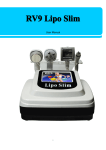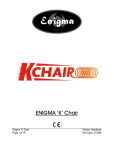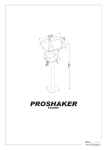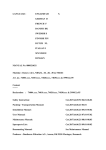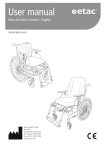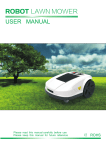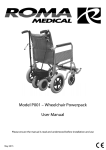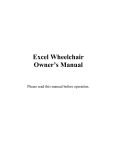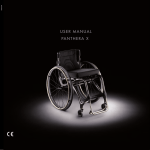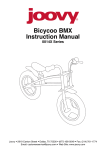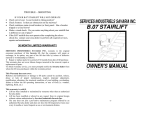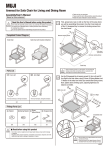Download Manual
Transcript
MINOS GLOBAL ALU User Manual Think Global Introduction Thank you for choosing a MINOS wheelchair. Our company is young but we have broad experience in the sector. The wheelchair you have just bought is the product of that experience. We are sure that the quality, durability and design of the chair will not disappoint you. Please read this manual for the use and maintenance of the chair carefully. If you have any questions, please ask your distributor who recommended the purchase of the wheelchair. Quality Standards Minos wheelchairs comply with the Medical Devices Directive 93/42/EEC (2007) and with the ISO 7176 standard. IMPORTANT INFORMATION BEFORE USING THE WHEELCHAIR Serial number Each chair comes with a sticker containing the serial number on the packaging box and the sideframe. The serial number identifies the date of production, batch and other relevant information about the wheelchair. Opening the chair Push down on the tubes supporting the seat upholstery, taking care not to pinch your fingers between the tube and the side frame. Ensure that the seat tubes are supported on their housing. The tie bar The function of the tie bar is to keep the sideframe parallel when folding and unfolding the chair. It also keeps the chair in folded position. Fitting the footrest Fit each footrest perpendicular to the sideframe in the hole shown in the photo. Once fitted, turn it 90° until it is fastened in position. To remove the footrest, press the lever, turn each footrest 90° outwards and pull them out. Tyre pressure Make sure that the tyres have the pressure recommended on the tyre wall. It is marked on the tyre itself. The recommended pressure is approximately 2.5 bar. The parking brake Check that the brakes work correctly. The brake is applied by pushing the lever forwards. To release the brake, pull the lever backwards. The brake spring will keep it separated from the wheel. We recommend you always apply the brakes when getting in or out of the wheelchair. WARNING: The parking brakes are not to be used to slow down the chair. Do not apply the brake while the chair is moving. WHEELCHAIR PARTS 6 7 5 1. Push-handles. 2. Backrest. 3. Armrest. 4. Armrest pad. 5. Rear wheel. 6. Aluminium handrim. 7. Quick-release axle. 8. Folding crossbar. 9. Detachable footrests. 10. Footplate. 11. Heel strap. 12. Front fork. 13. Caster wheel. 14. Padded seat with pocket. 15. Parking brake. GETTING IN AND OUT OF THE CHAIR First of all apply the parking brake. Do not use the footplates for support. Swing the armrest backwards and get in or out of the chair sideways or from the front, as recommended by the technician, occupational therapist or physiotherapist. Do not get in or out of the chair without the supervision of an attendant until you learn to do it easily. The WC The bathtub Side approach Front approach Front approach Side approach Transfer to a chair Transfer from the bed to the wheelchair Side approach Front approach Front approach Side approach ARMREST Folding or removing the armrest To remove the armrest, press the locking mechanism and pull the armrest backwards. To get in or out of the chair, leave the armrest in this position or remove it completely by simply turning it to release the pin and then pulling it out. To release the pin, the tab on the shaft must coincide with the groove in the hole. Adjusting the height of the armrest pad You do not need any tool to adjust the armrest height, just press the button on the outside of the armrest panel and choose the required height. SAFETY AND OPERATION Parts All the wheelchair parts and components are original and must not be replaced by other spareparts parts available on the market. The use of any part that is not an original Minos part renders the chair guarantee null and void. Please consult your distributor before replacing spare parts and/or components. Armrest and footrest Make sure that the armrest and footrest are securely fastened in position. Do not lift the chair by the armrest or footrest under any circumstances, since this could injure the user or damage the structure of the chair. Never stand up on the footplates. Make sure that the footrest is at the correct height from the floor so that it does not come into contact with it. Self-propelling For models with the standard 600 mm rear wheel. Use the handrim fitted to the rear wheels. Easy downward gradient Keep your back straight and use the handrim to move forward. Light upward gradient Bend your back forwards slightly and use the handrim to move forward. Turning round Use both handrims, turning them in opposite directions. Inclined plane (side position) Keep the side of the body slightly angled towards the higher part of the slope. Turning Hold the handrim on the side towards which you want to turn and use the other handrim to push forward. Parking brakes The brakes are not to be used to slow down the chair. Do not apply the brake while the chair is moving. Anti-tipping wheels (optional) The function of this safety device is to prevent the wheelchair from tipping over backwards. We recommend the use of anti-tip wheels at all times. Leaning forwards or backwards These movements could tip the chair over. Consequently, we recommend you make no sudden movements under any circumstances. If you need to lean backwards, keep your back against the back of the chair at all. If you need to lean forwards, make sure that the front wheels point forwards to give maximum support. Apply the parking brake and do not lean beyond the armrest. Falls from wheelchair If the chair tips over, position yourself in front of it and use your upper members to get in the correct position in the chair. Then ask another person to lift up the chair. Ramps and obstacles 90º Before trying to overcome an obstacle or go up a slope, make sure you have practised the manoeuvre with a technician, occupational therapist or other health-care professional. Do not try it on your own the first time. Have an attendant watch your manoeuvres until you acquire the necessary skill. Do not try to go up or down gradients of more than 10 per cent without help. Go over obstacles with both wheels at the same time (front wheels or rear wheels if you prefer to address the obstacle going backwards). Make sure that the footplates do not hit the floor when going up or down steps. Folding the chair Set the footplates of the footrest upright and pull up the seat upholstery until the chair is folded. Never exert force on the armrests or footrests to fold the chair. Tyres Make sure that the tyres have the pressure recommended on the tyre wall. Correct tyre pressure is essential for the manoeuvrability of the chair. The correct pressure also affects the performance of the parking brake. Street use Make sure at all times that your manoeuvres can be seen by passers-by, especially by vehicles if you have to cross the road. Cross the road at the appropriate place. FOLDING AND UNFOLDING THE CHAIR FOR CAR TRANSPORT To transport the wheelchair in the car, choose one of the following two options: • Place the folded chair in the area between the rear seats and the backrests of the front seats. • Place the folded chair in the car boot. If you prefer, you can remove the footrests and rear wheels with the quick-release axle. CONTROLS AND MAINTENANCE REPAIRS AND SPARE PARTS For repairs and spare parts, consult your distributor and they will advise you on the best option for your requirements. RECYCLING AND PACKAGING The cardboard in which the wheelchair is packaged is 100% recyclable. Please dispose of it in a rubbish container especially for cardboard. MINOS GLOBAL WHEELCHAIR MODELS MINOS GLOBAL ALU Self-propelled Ajusting the parking brake Adjust the brake according to the type of tyre, solid or pneumatic. Loosen the two clamp bolts, adjust the section for the brake shoe to work on the tyre and tighten the bolts. The gap between the tyre and the brake shoe should be maximum 6 mm. Adjusting the front fork The front fork has 3 holes where the caster wheel can be positioned according to the required front seat height. The front fork can also be adjusted in angle. The down axle of the front fork must always be at 90º angle with the floor. A template is provided with each chair to check the perpendicularity. Use a 5 mm allen key and undo the bolt half a turn (see picture). Then we need a second 5 mm allen key to complete the adjustment. As you can see in the picture we have to undo the bolt at the back and turn the allen key at the outside of the frame until with the help of the template we can measure a 90º angle. The cylinder that makes the adjustment possible has a red mark to remember the right position for our configuration. See the picture on the right for the right adjustment of the standard configuration with a 24” wheel at the rear wheel bracket and a 8” caster wheel. As you can see the caster wheel is in the lower hole of the front fork. Position of the rear wheel in the wheel bracket The rear wheel bracket has multiple positions where the rear wheel can be fixed. The picture on the left shows the fixation hole for the standard configuration. With this standard configuration the seat height at the front of the wheelchair is 50 cm, and 47 cm at the back. The seat angle can be varied by fixing the rear wheel in a different hole of the wheel bracket. In such a case we have to make sure that the angle of the down axle of the front fork is at 90º. To change the position in the wheel bracket of the QR axle bushing we need two 24 mm wrenches (see picture). In the outside of the side frame we have to place a washer and a Grower washer. For the inner part of the frame we only need a flat washer. Adjusting the seat depth To adjust the seat depth we need to undo the 4 bolts that fix the rear wheel bracket to the side frame. To do that we have to use a 5 mm allen key and a 10 mm wrench. Once we have undone the bolts we have to remove them and gently move the wheel bracket and the nylon part receiving the wheelchair handles until the required seat depth is achieved. Then we introduce the 4 bolts and have them done again. The standard configuration offers a seat depth of 42 cm. Following the above mentioned instructions we can also achieve seat depths of 44,5 and 47 cm. Each time we modify the seat depth we also have to modify the position of the parking brake and of the nylon part that receives the front part of the armrest. After each modification we have to check that the down axle of the front fork is at 90º with the floor. We may need to adjust the front fork as explained before. Adjusting the position of the wheelchair handles without modifying the position of the rear wheel bracket The MINOS GLOBAL wheelchair allows to move the handles of the wheelchair without modifying the position of the rear wheel bracket. This is useful if we need to exchange the standard sling backrest upholstery for a rigid backrest without losing seat depth. In the same way the postion of the rear wheel bracket can be changed without losing the seat depth of the chair. This means that we can adjust the wheel base distance so that we find the right balance between stability and manoeuvrability for each user. In both cases we have to undo the 4 bolts that fix the rear heel bracket and the nylon part receiving the handles and move one or the other depending on what we need. Reclining backrest (Optional) The MINOS GLOBAL wheelchair offers a reclining backrest as an option (the reclining range is from -6º to 10º). To recline the wheelchair backrest we have to turn both knobs clockwise. If we move the knobs anticlosewise the backrest would move upwards. The wheelchair with this option also offers a stretch bar that can be undone to fold the wheelchair. It is important to turn both knobs at the same time so that the backrest goes down or up in parallel. MINOS GLOBAL Transit (Attendant-propelled) Important Remark for the Attendant person: When not pushing the chair, please apply the parking brake at all times! Never leave the person/chair unattended. Dimensions and general information Minos Global Minos Global Transit Seat width 36, 40, 44, 48, 51 cm 36, 40, 44, 48, 51 cm Seat height 42-50 cm adjust. 50 cm Seat depth 42, 44,5 and 47 cm adjust. 42, 44,5 and 47 cm adjust. Backrest height 47 cm 47 cm Armrest height 18-26,5 cm adjust. 18-26,5 cm adjust. Total width Seat width + 20 cm Seat width + 15 cm Total height 93 cm 93 cm Total length Seat depth + 62 cm Seat depth + 55,5 cm Folded width 32,5 cm 26,5 cm Weight 16,3 kg * 16,5 kg * Transport weight 9,8 kg ** 13,9 kg *** Max. user’s weight 140 kg 140 kg * Weight without legrests. It can vary depending on accessories and options. ** Weight without legrests, armrests and rear wheels. *** Weight without legrests and armrests. Lifetime Guarantee for the crossbar and side frames. Distributed by:
















